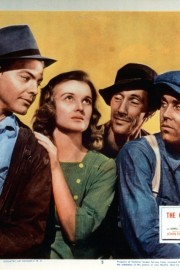The Grapes of Wrath
One of the things I’m most embarrassed to admit as a film fan is my lack of familiarity with the films of John Ford. To date, I have only seen his famous Western, “The Searchers,” and this film, based of the classic John Steinbeck novel set during the Great Depression. I still have a long way to go, but for my first review of Ford’s work, I’ll start with one I’ve seen.
This is one of those films I saw during school, and while I recognized its greatness, I didn’t really remember it very well. For me, the name of “Wrath’s” main character, Tom Joad, has resonated more in the song, and 1995 album, “The Ghost of Tom Joad” by Bruce Springsteen, which echoes Steinbeck’s themes in its stories of despair during rough economic times. It’s one of The Boss’s best, and as I started to watch Ford’s film for the first time about two decades, the haunting strains of that song came to mind again.
Today, however, is about the John Ford film. In it, we have Henry Fonda playing Tom Joad, who just got out of prison after four years for murder. When he goes back to the family home, he finds it deserted, although he finds one of his neighbors squatting in it, who lets him know what happened: that his family, and many others who worked in sharecropping, were forced off the land by banks and corporations. The Joads are making their way west to California, where the promise of good work, for good wages. The film is the story of their journey to a better future.
When they get to California, however, they find out that the reality is not as prosperous as their dream was. They set up in a “tent city,” where plenty of other families, who followed the same path west, find themselves in dire straights. The second half of the film chronicles the Joad’s attempts to make a home for themselves, and try to survive. Things start off rough, when their friend, Casy (John Carradine), a disillusioned ex-preacher, takes the fall for another person’s assault of an officer, and the family heads up North, trying to find work. They do, but Tom sees pretty plainly that something’s not quite fair with the way these people do business. He goes along with it, though, because he’s doing what’s best for his family, but when he and Casy’s paths cross again, Tom finds his purpose as a union organizer, looking to get the working man a good wage for good work done.
Steinbeck’s novel was published the year before this film was released, and it was universally acclaimed the second it hit book shelves for its stark reality, winning the Pulitzer Prize. Fox optioned the rights for the film, and put Ford, the great American chronicler of the West, at the helm. It was a logical choice, given Ford’s interest in our western movement over the years, even if his ideology seems in contrast to Steinbeck’s. Still, opposites attract, and it’s important to the film’s success that we have a director who can see the film’s narrative clearly, without pushing through an obvious agenda. As cinema, Ford and his cinematographer, Gregg Toland (who would shoot “Citizen Kane” the next year), lens the film with simple setups, and deep focus, the technique that allows for everything, foreground and background, in the shot to be seen clearly. That’s a smart visual approach to this material, where the main character’s eyes are opened up to the realities of the time and places he lives in. Ford’s storytelling is matched by the performances, including justly-famous turns by Fonda as Joad; Carradine; and Jane Darwell as Ma Joad, the loving matriarch of the family. The film feels like a documentary rather than a fictional narrative, and that comes from a perfect melding of material, actors, and a filmmaker who brought authenticity and honesty to any movie he made, and set a template filmmakers are still following to this day.










